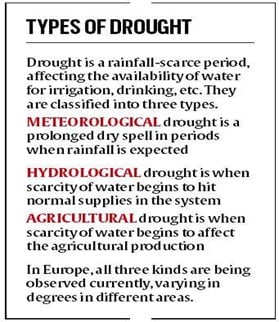Environment & Ecology, Geography
Context: Europe is experiencing the great drought.
- Some of Europe’s biggest rivers — Rhine, Po, Loire, Danube — which are usually formidable waterways, are unable to support even mid-sized boats.
- As water levels have fallen, remains of sunken ships and ominously named hunger stones — rocks engraved by previous generations during earlier periods of extraordinary dryness — have come out of erstwhile depths.
- The drought has been billed as the worst in 500 years.
- It is being said that never has a European summer been so dry since 1540, when a year-long drought killed tens of thousands of people.
- The dry spell this year follows a record-breaking heatwave that saw temperatures in many countries rise to historic highs.

The impact has been debilitating.
- Water transport has suffered badly, and is having cascading effects.
- Power production has been hit, leading to electricity shortages and a further increase in energy prices already pushed high by the war in Ukraine.
- Food is sharply more expensive in many countries, and drinking water is being rationed in some regions.
Worst in 500 years
- Earlier European droughts — such as those in 2003, 2010, and 2018 — too were compared to the 1540 event.
- Much like now, the 2018 drought was described as the “worst in 500 years”.
- But a senior scientist at the European Commission’s Joint Research Centre said this year could turn out to be worse than 2018, though data were still being analysed.
- The “worst in 500 years” description may be still not settled, but the impacts of this event are expected to be far worse than anything experienced in the recent past.
- Europe has been facing large scale climatic anomalies for over six months — precipitation has been far less than usual, while temperatures have soared to unprecedented levels.
- And this has come on top of the massive energy and food-supply implications of the Ukraine war.

Waterways and power
- Apart from agriculture and drinking water supplies, the most visible impact has been the disruption in Europe’s waterways.
- Europe depends heavily on its rivers to move cargo in an economical manner, including coal to power plants.
- With water levels down to less than a metre in some stretches, most large ships have been rendered unusable.
- Supply disruptions in coal has hit power generation.
- Lack of adequate water has affected the operation of nuclear power plants, which use large amounts of water as coolant.
- The result has been a shortage of electricity and an unprecedented rise in energy prices.
Drought in China, US too
- Many parts of China too are headed towards a serious drought, being described as the worst in 60 years.
- The country’s longest river, Yangtze, which caters to about a third of the Chinese population, is seeing water levels drop to record lows, according to a report in the South China Morning Post.
- Two of the country’s biggest freshwater lakes, Poyang and Dongting, have touched their lowest levels since 1951, the report said.
- The water scarcity is leading to problems similar to those in Europe. Power shortages in some areas have begun to force factories to shut, adding to the strain on global supply chains.
- Over 40% of the area in the United States too is under drought conditions currently, affecting about 130 million people, according to the US government.
Must Read: Drought in UP and Jharkhand
Source: Indian Express













